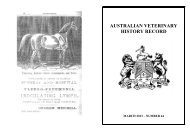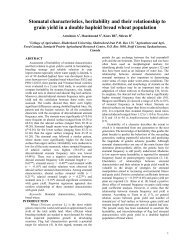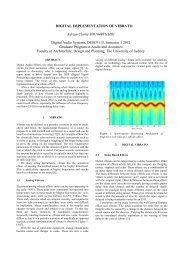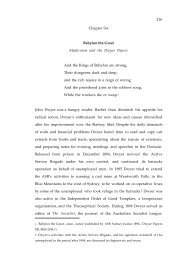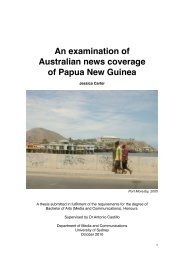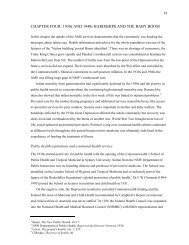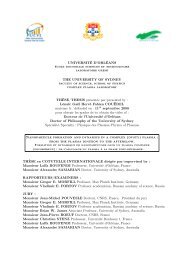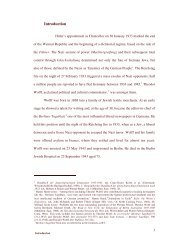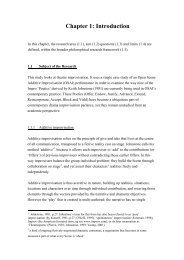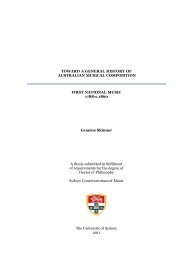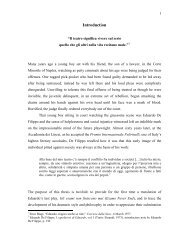journal of digital research & publishing - The Sydney eScholarship ...
journal of digital research & publishing - The Sydney eScholarship ...
journal of digital research & publishing - The Sydney eScholarship ...
You also want an ePaper? Increase the reach of your titles
YUMPU automatically turns print PDFs into web optimized ePapers that Google loves.
1 P M J O U R N A L O F D I G I T A L R ESEARCH & P UBLISHING<br />
facetoface relationship. In standard facetoface interaction, the sequence for relationship<br />
building begins with, 1) a need for spatial proximity and 2) physical attraction between two<br />
individuals. <strong>The</strong> sequence moves forward to, 3) a search for common ground or similarities<br />
once communication has commenced, and later continues on to 4) higher levels <strong>of</strong> self<br />
disclosure as a means <strong>of</strong> creating solidarity within the relationship. Correspondence based<br />
relationships, such as those formed through personal advertisements, follow an inverted<br />
sequence <strong>of</strong> these four criteria, tending to begin with 1) selfdisclosure in an attempt 2) to<br />
4"8&57007"&,>7("8&3"8&*$0$#3>$6$%*S&07I%&7"&67&\1&'+9*$53#&366>356$I%"%**&3*&3&'7$"6&7D&<br />
importance, and later, depending on the depth <strong>of</strong> the relationship, a decision to meet in<br />
person may cause a need for 4) spatial proximity. Reasons for this development include the<br />
fact that textual <strong>publishing</strong> removes the need to be physically near others to communicate,<br />
something which is traditionally necessary to form bonds. Self presentation through word<br />
also reduces the importance <strong>of</strong> physical attractiveness as a primary means <strong>of</strong> attraction,<br />
allows for great anonymity, and demands high levels <strong>of</strong> selfdisclosure as compared to<br />
facetoface relationships. <strong>The</strong>se variances on relationship development presented by<br />
the publication <strong>of</strong> personal ads, ‘represent a developmental and behavioural sequence far<br />
>%07I%8&D>70&5(*6703>9&0%6+78*&7D&4"8$",&366>356$7"&3"8&$"6$0359&G$6+&3"76+%>&'%>*7"L&<br />
(Merkle & Richardson 2000, p. 188189).<br />
If print and online personal advertisements are considered to be the same entity based<br />
on commonly shared characteristics, the question then arises as to why a shift in their<br />
publication to online contexts has taken place. Bolter and Grusin explain that, ‘every new<br />
medium diverges from, yet also reproduces, older media whereas old media refashions<br />
themselves to answer the challenges <strong>of</strong> new media.’ (Deuze 2006, p. 68). Applying this<br />
concept to the personal advertisement, one can argue that online publication has evolved<br />
from and reproduced traditional print media, and print type personal advertisements<br />
have refashioned themselves so as to become compatible with the Internet medium. In<br />
this way, the online personal advertisement can be seen as an evolution <strong>of</strong>, or extension on,<br />
its print publication counterpart.<br />
B+%>%&3>%&03"9&)%"%46*&7D&'()#$*+$",&8$,$63##9&>36+%>&6+3"&$"&'>$"6M&B+70'*7"&7(6#$"%*&<br />
six characteristics <strong>of</strong> <strong>digital</strong> <strong>publishing</strong> which have added value to their content over print<br />
publication: 1) Ease <strong>of</strong> access information placed online is not hindered by spatial and<br />
temporal constraints <strong>of</strong> print texts and thus is accessible at any moment by anyone who has<br />
an Internet connection and permission <strong>of</strong> access, even by multiple users simultaneously, 2)<br />
Updatability content can be updated quickly and frequently, 3) Scale large quantities <strong>of</strong><br />
35



